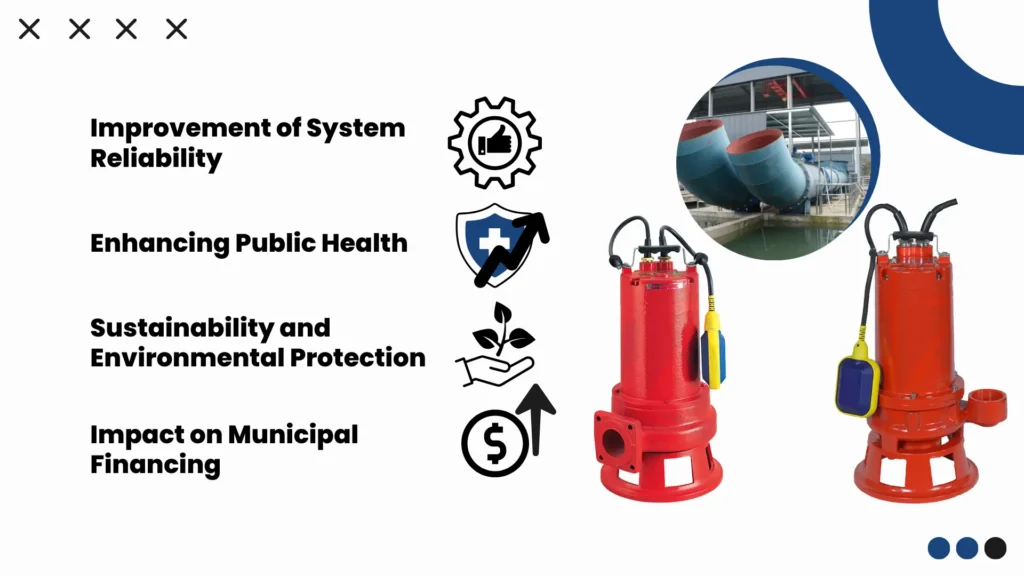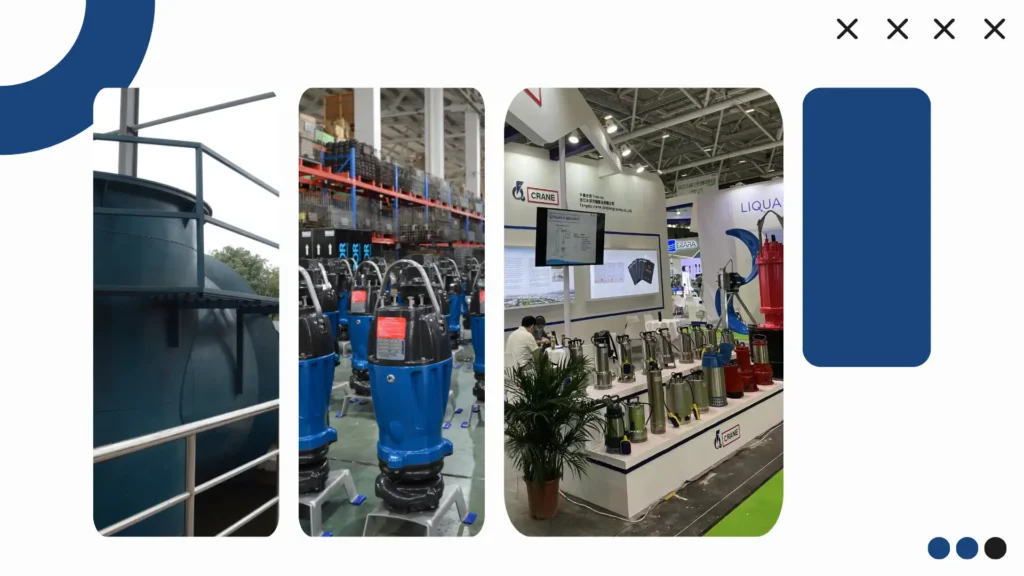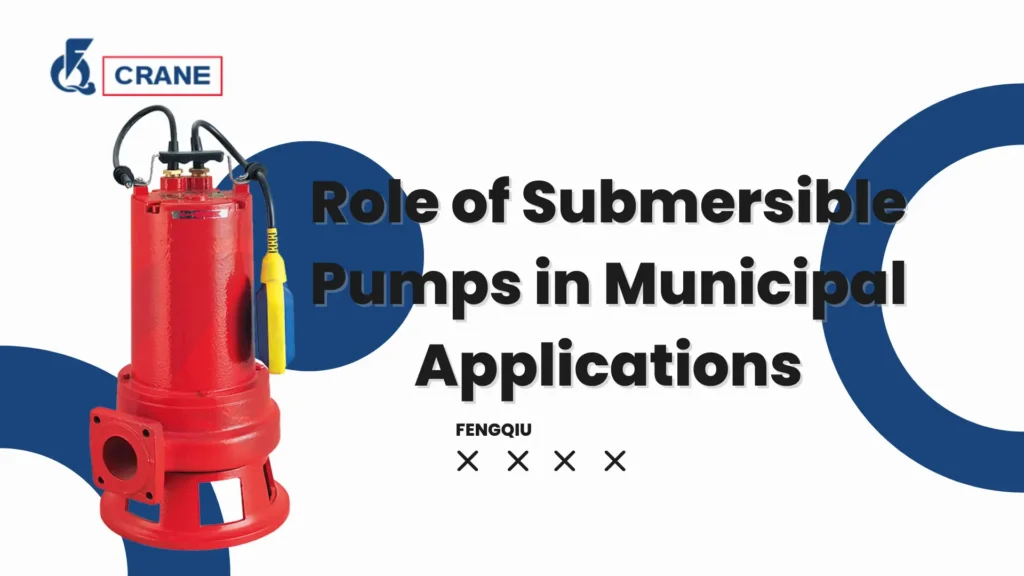Pumps, in particular submersible pumps, are unavoidable elements in the operation of municipal water supply systems.
The devices are made to be used while immersed in water and waste water, such that the devices pump the liquids from place to place.
For instance, the motor unit is well shielded from possible harm by water breeches thanks to their watertight structure.
While in the city where water resources need to be managed properly, submersible pumps are also important devices as they ensure that the water supply waste treatment and surface drainage systems are well operated.
The design of the pumps allows installing them deep underground while restricting the amount of surface equipment thus revolutionizing the design and performance of urban infrastructure.
Types of Submersible Pumps Used in Municipal Applications

Sewage Pumps
These are pumps designed to pump out sewage and customized in such a way of thermal dynamics that they can withhold all the appliable workload in any sewage systems.
Not only liquids but also such things that are ususally mixed with sewage like pieces of used toilet paper, turned wastes, food and some other effluents are also managed by these pumps.
Their hardy structures include structural devices such as grinders which shred larger solid objects to optimize flow and reduce the chances of blockages to the waste pipes.
Providing the apartment and business districts with sewage treatment facilities, sewage pumps uphold sanitation and hygiene in urban centers.
Drainage Pumps
As the name suggests, drainage pumps are used in most of the cases where there is a possibility of water pooling.
These pumps also find application in pumping out water from basements, construction sites, and such similar flooded areas.
Due to their light weight and portable nature, they can easily be installed and moved within a short time, hence very useful for drainages that are needed for short or emergency period.
Again, by preventing excessive water from accumulating, drainage pumps assist in reducing the risk of water-related destruction to buildings and infrastructure, therefore increasing the safety and practicality of the affected areas.
Effluent Pumps
These pumps are used to move treated water, also known as effluent, from the treatment centers to other sites where it may be discharged or used for other purposes, for example, irrigation.
As such pressure, gears and other turning mechanisms allow for such equipped water pumps to do a better job in pumping water that has no or very few solid contents enabling the treated water to be let out in the environment in an acceptable way.
Modern cities enhanced by the use of these pumps practice water rehabilitation onsite due to the ease in dealing with the pieces of equipment allowing for the treatment of effluent.
Key Municipal Applications
Wastewater Treatment Plants
In wastewater treatment works submersible pumps are used in the collection and transport of sewage and sludge from different points to the treatment works.
Their reliability and efficiency are important in preventing exceeding the capacity of any chamber before treated wastewater is discharged.
Related articles:
Application of Submersible Pumps in Wastewater Treatment

Stormwater Management
Due to harsh weather conditions such as heavy rainfall in a lot of cities, urban flood submersible pumps are used for storm drainage control.
They assist in at the very least managing and redirecting the excess rainfall to avoid destruction of residential and commercial properties as well as the existing infrastructure.
These pumps can come on and off as per the water levels and start pumping out water to the relevant discharge points.
Residential Sewage Systems
Most of the homes use submersible pumps for residential sewage systems as they are located lower than the municipal sewer lines.
They make it easier to transfer sewage from the house to the municipal sewage thereby making sure that there is no compromise of sanitary.
Industrial Wastewater Management
Industries tend to produce large volumes of waste water that calls for intensive management within the companies.
In order to ensure that environmental laws and regulations are adhered to, submersible pumps are put in use to move the waste water to the treatment facilities.
Advantages of Submersible Pumps in Municipal Settings
Space Enablement and Installation Adaptation
An essential merit of submersible pumps includes space savings due to their ability to be installed in almost any available working environment.
This adaptability is, nonetheless, most effective in cities since space is scarce.
Energy Efficiency and Cost Reduction
When one considers the power consumed, submersible pumps are usually superior to other types of pumps.
Their configuration ensures that less energy is wasted in vain; therefore, there is a lower expenditure by towns.
This efficiency on the other hand means a lot over a period of time, which ensures that the budget is friendly to the users.

Reduced Need for Maintenance
In submersible pumps, the external surroundings do not come into contact with any parts of the equipment due to the barrier/ lid construction.
This results in less erosion or damage for the particular mechanism.
As a result, such design will have less operational requirements hence a municipality will be able direct funds to other activities whilst there is constant service provision.
Sewage Pump Capabilities
Submersible pumps are also built to accommodate bulks and sludge making them suitable for use in sewage works.
This ensures that the wastewater treatment does not become inefficient even under adverse operating conditions.
Impact on Municipal Infrastructure
Improvement of System Reliability
The use of submersible pumps contributes to the reliability of municipal water distribution systems.
They are designed to work in a range of conditions enabling inflow and outflow operations to continue without interruptions.
Enhancing Public Health
Submersible pumps manage wastewater and stormwater therefore assisting in public health protection.
Adequate sewage treatment and disposal reduces the risk of waterborne diseases thus enhancing public health.
Also Read:
Understanding Residential and Municipal Submersible Pumps
Sustainability and Environmental Protection
Submersible pumps also promote better wastewater management protecting the environment from pollution.
These pumps play a roles in urban development by ensuring that treated effluents are safe for discharge to the environment.

Impact on Municipal Financing
The changeover to modern submersible pump systems can prove beneficial for the municipalities in the long run.
It’s better management of the budget due to low operating costs, a reduction in the need for maintenance, and higher dependability of the system.
Regulatory Considerations
Overview of Regulatory Considerations
Water management policy is subject to a number of regulations imposed on municipalities.
For example, they include environmental laws, standards for the effluent discharges, sanitary-hygienic norms, and utilization restrictions on submersible pumps.
Strategies for Municipalities to Ensure Compliance
Link with the preventive measures outlined above, municipalities should develop and implement strategies aimed at achieving compliance with the regulations which could include a program of routine inspections, maintenance, and staff training regarding water management regulations.
Importance of Permits and Regular Monitoring
Most situations would require a permit to fit and use submersible pumps.
Regular monitoring ensures these systems operate in conformity with local, state, and national regulations enhancing health and safety of the general population and protection of the environment.
Recommended Strategies
Municipalities can commit to an implementation of best practices that include but are not limited to keeping proper records, designing preventive maintenance schedules, and reviewing the regulatory environment periodically in order to reduce risks and improve performance.

Emerging Trends in Municipal Water Management
Emphasis of Sustainability Efforts
Another area that has come under consideration in the management of municipal water is the sustainability of the practices.
This includes employing submersible pumps which consume less energy and efforts aimed at controlling both usage and wastage of water.
Smart Technologies Integration
New methods of managing submersible pumps installed in various municipalities are being adopted thanks to smart technologies such as the IoT sensors and the automated system of monitoring.
These technologies increase operational efficiency and assist a great deal in data making processes.
Innovations in Policy and Availability of Funds
There has been politicization and adoption of changes in water management strategies to assist the municipalities manage their systems.
Grant schemes and these kinds of partnerships are ideal in providing the required funds for installation of sophisticated systems and restoring the facilities.
Capacity Building and Sensitization
It is also important to involve the people in the fight against wastage of water and other resources.
People need to be made aware of how sewage treatment is a necessary part of their living environment and how they should not waste to help the Russian municipalities.

Conclusion
Municipal water management would not be possible without submersible pumps, which is largely attributed to their high efficiency and low-maintenance reliability.
Submersible pumps play a prominent part in the treatment and removal of waste as well as the management of stormwater and even industries – all of which have relevance in urban settings.
Looking into the future, it’s easy to predict that submersible pumps will undergo improvement in newer applications in the course driven by improvement in technology and improvement in people’s attitude with regards to sustainability.
Consequently, these enable better practices on water management, hygiene promotion, and sustainable development of cities for the future generations.

